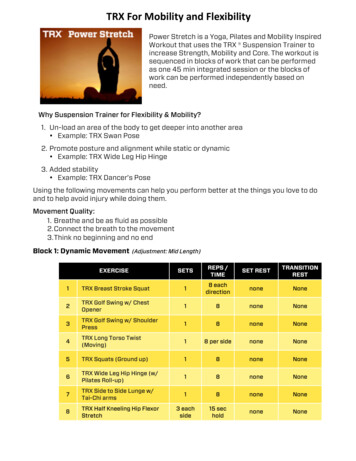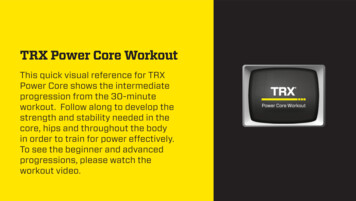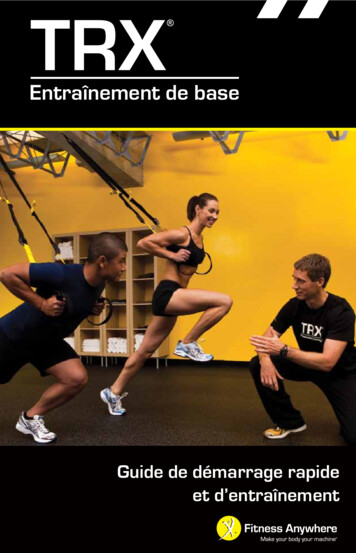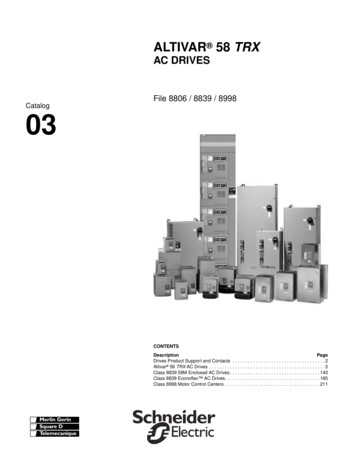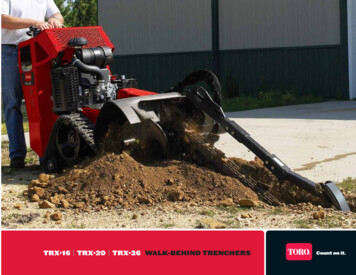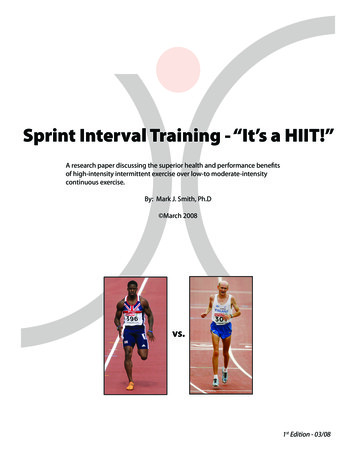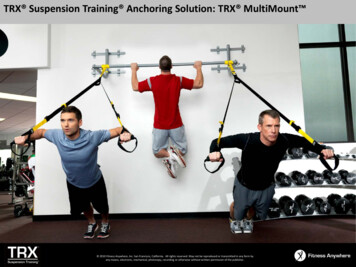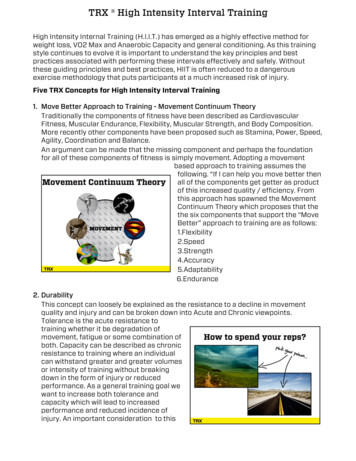
Transcription
TRX High Intensity Interval TrainingHigh Intensity Internal Training (H.I.I.T.) has emerged as a highly effective method forweight loss, VO2 Max and Anaerobic Capacity and general conditioning. As this trainingstyle continues to evolve it is important to understand the key principles and bestpractices associated with performing these intervals effectively and safely. Withoutthese guiding principles and best practices, HIIT is often reduced to a dangerousexercise methodology that puts participants at a much increased risk of injury.Five TRX Concepts for High Intensity Interval Training1. Move Better Approach to Training - Movement Continuum TheoryTraditionally the components of fitness have been described as CardiovascularFitness, Muscular Endurance, Flexibility, Muscular Strength, and Body Composition.More recently other components have been proposed such as Stamina, Power, Speed,Agility, Coordination and Balance.An argument can be made that the missing component and perhaps the foundationfor all of these components of fitness is simply movement. Adopting a movementbased approach to training assumes thefollowing. “If I can help you move better thenall of the components get getter as productof this increased quality / efficiency. Fromthis approach has spawned the MovementContinuum Theory which proposes that thethe six components that support the “MoveBetter” approach to training are as Adaptability6.Endurance2. DurabilityThis concept can loosely be explained as the resistance to a decline in movementquality and injury and can be broken down into Acute and Chronic viewpoints.Tolerance is the acute resistance totraining whether it be degradation ofmovement, fatigue or some combination ofboth. Capacity can be described as chronicresistance to training where an individualcan withstand greater and greater volumesor intensity of training without breakingdown in the form of injury or reducedperformance. As a general training goal wewant to increase both tolerance andcapacity which will lead to increasedperformance and reduced incidence ofinjury. An important consideration to this
TRX High Intensity Interval Trainingend is “how do we want to spend our reps of higher risk movements?” As an example,if life or sport demands lumbar spinal flexion and we are award that there aresignificant risks associated with this motion then we will want to limit the performanceof this motion in training as it could significantly reduce the tolerance and or capacityfor our training.3. What Should Be Stable? What Should Be Mobile?To ensure a high quality of movement, professional practitioners must have a strongunderstanding of what should be stable and what should be mobile. Where should themovement be coming from and just asimportantly, where should it not be comingfrom? Generally speaking the body’s jointsare organized in an alternating cadencewhere the foot, knee, lumbar spine andcervical spine are stable and the ankle, hip,thoracic spine and shoulder joints aremobile. This is of course a generalizationand the reality is that “what should be stableand what should be mobile” needs to beunderstood and assessed on a movementby movement basis to maximize durabilityand performance.4. High Intensity Intervals Based on Strong Focused MovementsThe application of high intensity intervalsneeds to be predicated on the successfuland skillful performance of strong focusedmovements. The nature of HIIT is thatexercises are often performed at highspeed and in many cases in motivating,competitive environments where quantitycan overtake the priority of quality. Amantra to help avoid this state is “It is notwhat you do but HOW you do it thatcounts.” Time must be taken to teachstrong focused movements before5. Earn The Right To ProgressRelated to the previously described principle, “Earn the right to progress” describesthe process by which users of H.I.I.T. should move through progressions of trainingvariables. Initially participants must learn the right progression to perform where theycan be successful with the training volume while meeting all movement standards.Once this baseline is established increases in intensity must be earned incrementallyby perfecting the established progression prior to adding more challenge on to a giventraining variable. It is equally important to only increase one training variable at a time.
TRX High Intensity Interval TrainingTRX Programming “best practices” for High Intensity Interval Training1. Exercise SelectionThere are 3 main considerations to address when looking at exercise selection forH.I.I.T. with the Suspension Trainer and / or the Rip Trainer.1. What are the foundational movements?2. What are the primary planes of motions at which joints?3. What is the body position in relation to the anchor point?An awareness of these considerations will ensure purposeful decisions aroundexercise selection and align the programming properly with the objectives for theworkout.2. Exercise SequencingThe three considerations for exercise sequencing as follows:1. Local muscular fatigue2. Modality order3. Body position in relation to the anchor point3. Set ArrangementFor HIIT the best set arrangement is generally a time based approach. This allows forthe following advantages: Better for groups if sharing equipment as individuals will finish sets at the sametime regardless of their ability level Allows for individualization of training intensity in a group environment 1 / -1 Concept supports the Move Better approach to training and puts the emphasison a high movement quality throughout the training session4. Intensity Selection1. Duration2. Resistance3. Speed of MovementAll of the above considerations should be individualized and skill and conditioningdependent and allow for high quality movement throughout the set, round andworkout.5. Rest Structure1. Rest ResetSet and transition rest should be individualized and skill and conditioning dependentwhile kept to a minimum while allowing high quality movement throughout the set,round and workout2. RESET - Quality Control Measureallowing the reset promotes better movement and puts the emphasis on quality asopposed to volume - it’s not what you do but how you do it that counts - Not 1 set of 12- 12 sets of 1 concept
TRX High Intensity Interval Training6. Progression System1. 3 Major levels of Progression:1. Entry2. Advanced3. Pinnacle2. Training Variable Progression Order:1. Reset Volume2. Set Rest3. Transition Rest4. Set time5. Resistance6. Round #3. Master each micro progression before moving on to the nextExampleExerciseSetsRepsSet RestTransitionRest1ST Cycle Jumps260 seconds (5 & reset, /- 1 option)10 sec30 secPinnacle2RT Samurai Strike2 (1 each side)60 seconds (5 & reset, /- 1 option)10 sec30 sec1 to 3Rounds3ST Atomic Pushup260 seconds (5 & reset, /- 1 option)10 sec30 sec4RT Squat Row2 (1 each side)60 seconds (5 & reset, /- 1 option)10 sec30 sec1ST Cycle Jumps245 seconds (3 & reset, /- 1 option)20 sec45 secAdvanced2RT Samurai Strike2 (1 each side)45 seconds (3 & reset, /- 1 option)20 sec45 sec1 to 2Rounds3ST Atomic Pushup245 seconds (3 & reset, /- 1 option)20 sec45 sec4RT Squat Row2 (1 each side)45 seconds (3 & reset, /- 1 option)20 sec45 sec1ST Cycle Jumps230 seconds (1 & reset, 1 option)30 sec60 sec2RT Samurai Strike2 (1 each side)30 seconds (1 & reset, 1 option)30 sec60 sec3ST Atomic Pushup230 seconds (1 & reset, 1 option)30 sec60 sec4RT Squat Row2 (1 each side)30 seconds (1 & reset, 1 option)30 sec60 secRoundEntry1 Round
TRX High Intensity Interval TrainingH.I.I.T. WorkoutMovementPrepEXERCISESETSREPS / TIMESETRESTTRANSITIONREST1ST Cycle Jumps3-5 1 up to 3 - 55-10sec1 to 2minutes2RT Samurai Strike3 - 5 eachside 1 up to 3 - 55-10sec1 to 2minutes3ST Atomic Pushup3-5 1 up to 3 - 55-10sec1 to 2minutes4RT Squat Row3 - 5 eachside 1 up to 3 - 55-10sec1 to 2minutes1ST Cycle Jumps245 seconds (3 &reset, /- 1 option)15 sec30 sec2RT Samurai Strike2 (1 eachside)45 seconds (3 &reset, /- 1 option)15 sec30 sec3ST Atomic Pushup245 seconds (3 &reset, /- 1 option)15 sec30 sec4RT Squat Row2 (1 eachside)45 seconds (3 &reset, /- 1 option)15 sec30 sec1ST Balance Lunge(SLOW and pause)1 each side45 seconds15 sec30 sec2RT Samurai Strike(SLOW with stack)1 each side45 seconds15 sec30 sec3ST Atomic Pushup(SLOW and pause)245 seconds15 sec30 sec4RT Squat Row with Ward(SLOW and hold)1 each side45 seconds15 sec30 secH.I.I.TStrength
TRX High Intensity Interval Training1. ST Cycle Jump2. Rip Samurai Strike3. ST Atomic Pushup4. Rip Squat Row
TRX High Intensity Interval Training. H.I.I.T. Workout EXERCISE SETS REPS / TIME SET REST TRANSITION REST Movement Prep 1 ST Cycle Jumps 3 - 5 1 up to 3 - 5 5-10 sec 1 to 2 minutes 2 RT Samurai Strike 3 - 5 each side 1 up to 3 - 5 5-10 sec 1 to 2 minutes 3 ST A
